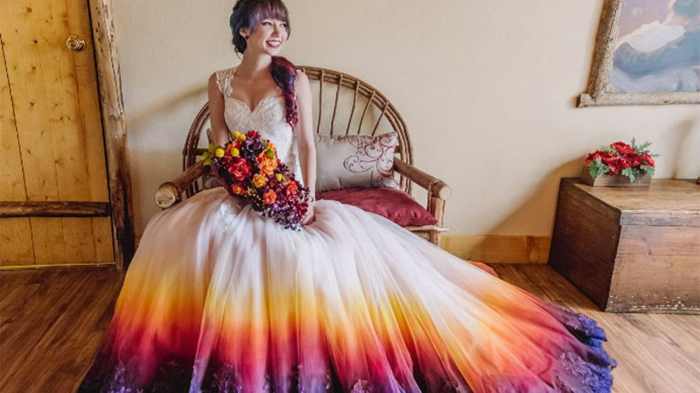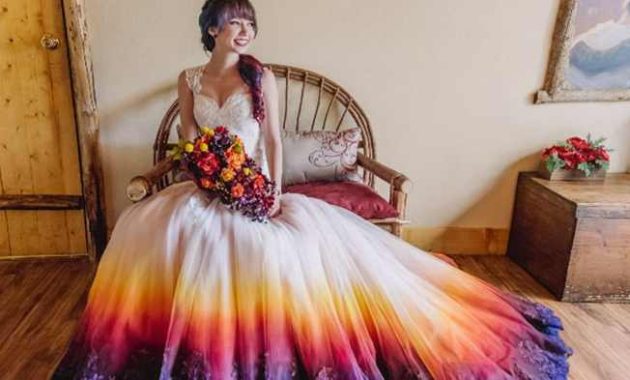Wedding Guest Dress Code Etiquette
Color dress for wedding – Understanding wedding dress codes is crucial for choosing an appropriate outfit. Different dress codes signify varying levels of formality, directly influencing color choices. Misinterpreting a dress code can lead to feeling underdressed or overdressed, potentially causing discomfort for both you and the hosts.
Dress Code Nuances and Color Implications
Dress codes like “black-tie,” “cocktail,” and “casual” each have distinct color implications. Black-tie events generally call for darker, more formal colors, while cocktail attire allows for a broader range, including jewel tones and brighter shades. Casual weddings often have the most flexibility, but even then, certain colors might be considered inappropriate (like bright white).
Appropriate and Inappropriate Color Choices
For black-tie events, deep jewel tones like emerald green, sapphire blue, or ruby red are appropriate. Avoid bright, pastel, or overly casual colors. Cocktail attire allows for more versatility. Pastels, jewel tones, and even some bolder colors can work well. However, avoid anything too casual or overly flashy.
For casual weddings, most colors are acceptable, but it’s generally advisable to steer clear of white (reserved for the bride) and overly somber colors like black.
Navigating Unconventional Dress Codes
If the dress code is unclear or unconventional, it’s best to reach out to the couple or a member of the wedding party for clarification. A simple email or phone call can prevent any potential wardrobe mishaps. Alternatively, look for clues in the wedding invitation’s design or the overall theme of the wedding to gain a better understanding of the expected attire.
Dress Code Formality and Suggested Color Palettes

Source: s-nbcnews.com
| Dress Code | Formality Level | Suggested Colors | Colors to Avoid |
|---|---|---|---|
| Black-Tie | Formal | Navy, Black, Emerald Green, Sapphire Blue, Burgundy | Bright White, Pastel Shades, Neon Colors |
| Cocktail | Semi-Formal | Jewel Tones, Pastels, Navy, Blush Pink, Coral | Bright White, Very Casual Colors, Extremely Bold Colors |
| Casual | Informal | Most Colors (except white), Floral Prints, Light and Airy Shades | Bright White, Extremely Dark Colors (unless specified) |
Color Psychology in Wedding Attire
Color psychology plays a significant role in influencing the overall atmosphere of a wedding and the emotional responses of guests. Certain colors evoke specific feelings and have cultural significance, making color selection a critical aspect of wedding attire.
Emotional Impact and Cultural Significance of Colors
Red is often associated with passion and excitement, while blue represents tranquility and serenity. Green symbolizes nature and growth, whereas pastels generally convey a sense of softness and elegance. Cultural significance varies; for example, white is traditionally associated with purity in Western cultures but may hold different meanings in other parts of the world. It is important to be mindful of these cultural nuances.
Harmonious Color Combinations
Complementary colors (opposite each other on the color wheel, like blue and orange) create vibrant contrasts, while analogous colors (adjacent on the color wheel, like blue, blue-green, and green) offer a more harmonious and soothing effect. Monochromatic palettes (using different shades of a single color) create a sophisticated and elegant look. Experimenting with different combinations is key to finding what works best.
Mood Board: Illustrating Color Palette Effects
Imagine a mood board showcasing three distinct color palettes. The first, featuring deep blues and golds, evokes a sense of regal elegance and sophistication, suitable for a formal evening wedding. The second, with soft pinks, lavenders, and creams, creates a romantic and dreamy atmosphere, perfect for a garden wedding. The third, using bright corals, sunny yellows, and vibrant greens, projects a cheerful and energetic vibe, ideal for a beach wedding.
Each palette utilizes texture and varying shades to create depth and visual interest.
Finding the Perfect Color Dress
Choosing the perfect color dress involves considering various factors to ensure a flattering and appropriate outfit for the wedding. Skin tone, body type, personal style, and the season all play a role in the decision-making process.
Selecting a Color Considering Skin Tone, Body Type, and Style
Warm skin tones often look best in warm colors like gold, orange, and red-toned hues. Cool skin tones generally complement cool colors such as blues, greens, and purples. Consider your body type when selecting a silhouette and color that accentuates your best features. Personal style should also be a guide, ensuring the dress reflects your personality and comfort level.
Fabric Types and Seasonal Suitability
Lighter fabrics like cotton, linen, and silk are ideal for warmer seasons, while heavier fabrics such as velvet, wool, and brocade are better suited for cooler weather. The fabric’s drape and texture should also be considered to achieve a flattering look.
Step-by-Step Guide to Finding a Flattering Dress
- Determine the wedding’s dress code and venue.
- Identify your skin tone and body type.
- Browse different color options considering your skin tone and the wedding’s atmosphere.
- Try on various styles and fabrics to find the most flattering silhouette.
- Consider the season and choose appropriate fabrics.
- Finalize your choice based on comfort and personal style.
Incorporating Accessories
Accessories can significantly enhance a dress. A statement necklace can add elegance, while a colorful scarf can inject personality. Shoes and a handbag should complement the dress color and overall wedding aesthetic, without overpowering the outfit.
Color Dress Options for Different Wedding Settings
The wedding venue and theme significantly influence appropriate color choices. A beach wedding might call for lighter, brighter colors, while a ballroom wedding might lend itself to more formal and sophisticated hues. The overall wedding décor should also be considered.
Choosing a color for your wedding dress is a significant decision. Many brides opt for classic white, but a range of colors are becoming increasingly popular. If you’re considering a softer, romantic palette, you might explore options like blush pink, and for exquisite designs in this shade, check out the beautiful selection of blush Hayley Paige wedding dresses.
Ultimately, the best color for your wedding dress depends on your personal style and the overall aesthetic of your wedding.
Color Suggestions for Different Venues and Themes, Color dress for wedding
The choice of color should complement the venue and theme, creating a cohesive and visually appealing look.
- Beach Wedding: Pastel blues, corals, yellows, and whites.
- Garden Wedding: Floral prints, soft greens, lavenders, and blush pinks.
- Ballroom Wedding: Jewel tones, deep blues, burgundies, and blacks.
- Rustic Wedding: Earthy tones, muted greens, browns, and creams.
- Modern Wedding: Bold colors, metallic accents, and sleek silhouettes.
- Romantic Wedding: Soft pinks, lavenders, blush tones, and creams.
Accessorizing a Color Dress for a Wedding: Color Dress For Wedding
Accessories play a vital role in completing a wedding guest outfit. They should complement the dress color without clashing and should align with the overall wedding aesthetic. Careful selection ensures a polished and cohesive look.
Choosing Complementary Accessories
Jewelry, shoes, and handbags should be chosen to enhance, not detract from, the dress. For instance, a bold colored dress might pair well with neutral-toned accessories, while a more subdued dress might benefit from a statement piece of jewelry. Consider the overall style of the wedding when making your selections.
Accessory Styles for Different Dress Colors
A navy blue dress might be paired with gold jewelry and nude heels, while a coral dress could be complemented with silver jewelry and bright pink shoes. A black dress could be dressed up with sparkly jewelry and elegant heels, or dressed down with simpler accessories depending on the occasion’s formality.
Visual Guide: Accessory Combinations
Imagine a visual guide showcasing different accessory combinations for various dress colors. One section features a vibrant emerald green dress paired with delicate silver jewelry, nude heels, and a clutch in a complementary shade of green. Another showcases a blush pink dress with gold jewelry, blush pink heels, and a white handbag. A third section shows a navy blue dress paired with gold jewelry, black heels, and a small black clutch.
Each combination is carefully curated to showcase the versatility of accessories and their ability to enhance the overall look.
Quick FAQs
Can I wear white to a wedding?
Generally, no. White is traditionally reserved for the bride. Unless explicitly stated otherwise by the couple, avoid white or off-white dresses.
What colors are generally considered inappropriate for weddings?
Very bright, attention-grabbing colors that might overshadow the bride are generally discouraged. This includes overly bold neon shades.
What if the invitation doesn’t specify a dress code?
If there’s no dress code, a semi-formal or cocktail dress in a sophisticated color is a safe bet. Avoid anything too casual or overly formal.
How do I choose a dress color that complements my skin tone?
Warm skin tones generally look best in warm colors (e.g., gold, peach, coral), while cool skin tones suit cooler colors (e.g., silver, blue, purple). Experiment to find what flatters you best.

